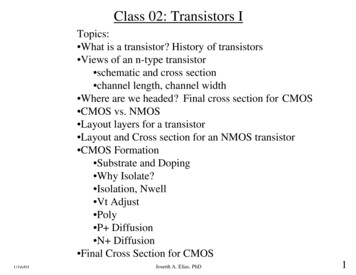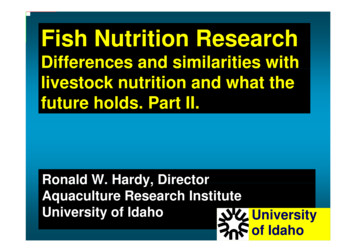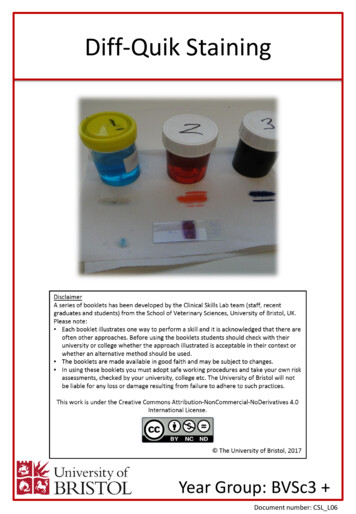![[MS-EFSR-Diff]: Encrypting File System Remote (EFSRPC) Protocol](/img/29/5bms-efsr-5d-211006-diff.jpg)
Transcription
[MS-EFSR-Diff]:Encrypting File System Remote (EFSRPC) ProtocolIntellectual Property Rights Notice for Open Specifications Documentation Technical Documentation. Microsoft publishes Open Specifications documentation (“thisdocumentation”) for protocols, file formats, data portability, computer languages, and standardssupport. Additionally, overview documents cover inter-protocol relationships and interactions.Copyrights. This documentation is covered by Microsoft copyrights. Regardless of any otherterms that are contained in the terms of use for the Microsoft website that hosts thisdocumentation, you can make copies of it in order to develop implementations of the technologiesthat are described in this documentation and can distribute portions of it in your implementationsthat use these technologies or in your documentation as necessary to properly document theimplementation. You can also distribute in your implementation, with or without modification, anyschemas, IDLs, or code samples that are included in the documentation. This permission alsoapplies to any documents that are referenced in the Open Specifications documentation.No Trade Secrets. Microsoft does not claim any trade secret rights in this documentation.Patents. Microsoft has patents that might cover your implementations of the technologiesdescribed in the Open Specifications documentation. Neither this notice nor Microsoft's delivery ofthis documentation grants any licenses under those patents or any other Microsoft patents.However, a given Open Specifications document might be covered by the Microsoft OpenSpecifications Promise or the Microsoft Community Promise. If you would prefer a written license,or if the technologies described in this documentation are not covered by the Open SpecificationsPromise or Community Promise, as applicable, patent licenses are available by contactingiplg@microsoft.com.License Programs. To see all of the protocols in scope under a specific license program and theassociated patents, visit the Patent Map.Trademarks. The names of companies and products contained in this documentation might becovered by trademarks or similar intellectual property rights. This notice does not grant anylicenses under those rights. For a list of Microsoft trademarks, visitwww.microsoft.com/trademarks.Fictitious Names. The example companies, organizations, products, domain names, emailaddresses, logos, people, places, and events that are depicted in this documentation are fictitious.No association with any real company, organization, product, domain name, email address, logo,person, place, or event is intended or should be inferred.Reservation of Rights. All other rights are reserved, and this notice does not grant any rights otherthan as specifically described above, whether by implication, estoppel, or otherwise.Tools. The Open Specifications documentation does not require the use of Microsoft programmingtools or programming environments in order for you to develop an implementation. If you have accessto Microsoft programming tools and environments, you are free to take advantage of them. CertainOpen Specifications documents are intended for use in conjunction with publicly available standardsspecifications and network programming art and, as such, assume that the reader either is familiarwith the aforementioned material or has immediate access to it.Support. For questions and support, please contact dochelp@microsoft.com.1 / 94[MS-EFSR-Diff] - v20211006Encrypting File System Remote (EFSRPC) ProtocolCopyright 2021 Microsoft CorporationRelease: October 06, 2021
Revision /20071.0NewVersion 1.0 release4/3/20071.1MinorVersion 1.1 release5/11/20071.2MinorVersion 1.2 release6/1/20071.2.1EditorialChanged language and formatting in the technical content.7/3/20071.3MinorClarified the meaning of the technical content.8/10/20072.0MajorUpdated and revised the technical content.9/28/20073.0MajorConverted to unified format.10/23/20073.1MinorClarified the meaning of the technical content.1/25/20083.1.1EditorialChanged language and formatting in the technical content.3/14/20083.1.2EditorialChanged language and formatting in the technical content.6/20/20084.0MajorUpdated and revised the technical content.7/25/20084.0.1EditorialChanged language and formatting in the technical content.8/29/20084.0.2EditorialChanged language and formatting in the technical content.10/24/20084.0.3EditorialChanged language and formatting in the technical content.12/5/20085.0MajorUpdated and revised the technical content.1/16/20095.0.1EditorialChanged language and formatting in the technical content.2/27/20095.0.2EditorialChanged language and formatting in the technical content.4/10/20095.0.3EditorialChanged language and formatting in the technical content.5/22/20096.0MajorUpdated and revised the technical content.7/2/20096.0.1EditorialChanged language and formatting in the technical content.8/14/20096.0.2EditorialChanged language and formatting in the technical content.9/25/20097.0MajorUpdated and revised the technical content.11/6/20098.0MajorUpdated and revised the technical content.12/18/20099.0MajorUpdated and revised the technical content.1/29/201010.0MajorUpdated and revised the technical content.3/12/201011.0MajorUpdated and revised the technical content.4/23/201011.0.1EditorialChanged language and formatting in the technical content.6/4/201012.0MajorUpdated and revised the technical content.7/16/201013.0MajorUpdated and revised the technical content.8/27/201014.0MajorUpdated and revised the technical content.2 / 94[MS-EFSR-Diff] - v20211006Encrypting File System Remote (EFSRPC) ProtocolCopyright 2021 Microsoft CorporationRelease: October 06, 2021
5.0MajorUpdated and revised the technical content.11/19/201015.0NoneNo changes to the meaning, language, or formatting of thetechnical content.1/7/201115.0NoneNo changes to the meaning, language, or formatting of thetechnical content.2/11/201116.0MajorUpdated and revised the technical content.3/25/201117.0MajorUpdated and revised the technical content.5/6/201117.0NoneNo changes to the meaning, language, or formatting of thetechnical content.6/17/201117.1MinorClarified the meaning of the technical content.9/23/201118.0MajorUpdated and revised the technical content.12/16/201119.0MajorUpdated and revised the technical content.3/30/201219.0NoneNo changes to the meaning, language, or formatting of thetechnical content.7/12/201219.0NoneNo changes to the meaning, language, or formatting of thetechnical content.10/25/201220.0MajorUpdated and revised the technical content.1/31/201320.0NoneNo changes to the meaning, language, or formatting of thetechnical content.8/8/201321.0MajorUpdated and revised the technical content.11/14/201321.0NoneNo changes to the meaning, language, or formatting of thetechnical content.2/13/201421.0NoneNo changes to the meaning, language, or formatting of thetechnical content.5/15/201421.0NoneNo changes to the meaning, language, or formatting of thetechnical content.6/30/201522.0MajorSignificantly changed the technical content.10/16/201523.0MajorSignificantly changed the technical content.7/14/201624.0MajorSignificantly changed the technical content.6/1/201724.0NoneNo changes to the meaning, language, or formatting of thetechnical content.9/15/201725.0MajorSignificantly changed the technical content.12/1/201725.0NoneNo changes to the meaning, language, or formatting of thetechnical content.9/12/201826.0MajorSignificantly changed the technical content.4/7/202127.0MajorSignificantly changed the technical content.6/25/202128.0MajorSignificantly changed the technical content.3 / 94[MS-EFSR-Diff] - v20211006Encrypting File System Remote (EFSRPC) ProtocolCopyright 2021 Microsoft CorporationRelease: October 06, 2021
9.0MajorSignificantly changed the technical content.4 / 94[MS-EFSR-Diff] - v20211006Encrypting File System Remote (EFSRPC) ProtocolCopyright 2021 Microsoft CorporationRelease: October 06, 2021
Table of Contents1Introduction . 71.1Glossary . 71.2References . 111.2.1Normative References . 121.2.2(Updated Section) Informative References . 121.3Overview . 131.4Relationship to Other Protocols . 171.5Prerequisites/Preconditions . 181.6Applicability Statement . 181.7Versioning and Capability Negotiation . 181.8Vendor-Extensible Fields . 191.9Standards Assignments. 192Messages . 202.1Transport . 202.2Common Data Types . 202.2.1EFSRPC Identifiers . 202.2.2EFSRPC Metadata . 202.2.2.1EFSRPC Metadata Version 1 . 212.2.2.1.1Key List Structure . 232.2.2.1.2Key List Entry . 232.2.2.1.3Public Key Information . 242.2.2.1.4Certificate Data . 262.2.2.1.5Encrypted FEK . 272.2.2.2EFSRPC Metadata Version 2 . 282.2.2.2.1Protector List Structure . 302.2.2.2.2EFSX Datum . 302.2.2.2.3Blob Datum . 322.2.2.2.4Descriptor Datum . 332.2.2.2.5Protector List Entry . 332.2.2.2.6Protector Info Datum . 342.2.2.2.7Key Agreement Datum . 352.2.2.2.8Fek Info Datum . 352.2.2.2.9DPAPI-NG Datum . 362.2.2.3EFSRPC Metadata Version 3 . 362.2.3EFSRPC Raw Data Format . 382.2.3.1Marshaled Stream . 392.2.3.2Stream Data Segment . 412.2.3.3Data Segment Encryption Header . 412.2.3.4Extended Header . 432.2.4PEXIMPORT CONTEXT HANDLE . 432.2.5EFS EXIM PIPE . 432.2.6EFS CERTIFICATE BLOB . 432.2.7EFS HASH BLOB . 442.2.8ENCRYPTION CERTIFICATE . 442.2.9ENCRYPTION CERTIFICATE LIST . 442.2.10ENCRYPTION CERTIFICATE HASH . 452.2.11ENCRYPTION CERTIFICATE HASH LIST . 452.2.12EFS RPC BLOB . 452.2.13ALG ID . 462.2.14EFS KEY INFO . 462.2.15EFS COMPATIBILITY INFO . 462.2.16EFS ENCRYPTION STATUS INFO . 472.2.17EFS DECRYPTION STATUS INFO . 472.2.18ENCRYPTED FILE METADATA SIGNATURE . 475 / 94[MS-EFSR-Diff] - v20211006Encrypting File System Remote (EFSRPC) ProtocolCopyright 2021 Microsoft CorporationRelease: October 06, 2021
2.2.192.2.20ENCRYPTION PROTECTOR . 48ENCRYPTION PROTECTOR LIST . 483Protocol Details . 503.1Server Details . 503.1.1Abstract Data Model . 503.1.1.1User-Certificate Binding . 513.1.1.2EFSRPC Server Control . 523.1.2Timers . 523.1.3Initialization . 523.1.4Message Processing Events and Sequencing Rules . 523.1.4.1Application Requests for a User-Certificate Binding . 523.1.4.1.1EFS Certificate Enrollment Algorithm . 533.1.4.1.1.1Inputs . 533.1.4.1.1.2Outputs . 533.1.4.1.1.3Internal Variables . 533.1.4.1.1.4Processing Rules . 533.1.4.1.1.4.1Building a List of CAs that Support a Particular Template . 533.1.4.1.1.4.2Creating a Request . 543.1.4.2EFSRPC Interface . 543.1.4.2.1(Updated Section) Receiving an EfsRpcOpenFileRaw Message (Opnum 0) 583.1.4.2.2Receiving an EfsRpcReadFileRaw Message (Opnum 1) . 603.1.4.2.3Receiving an EfsRpcWriteFileRaw Message (Opnum 2) . 603.1.4.2.4Receiving an EfsRpcCloseRaw Message (Opnum 3) . 613.1.4.2.5Receiving an EfsRpcEncryptFileSrv Message (Opnum 4) . 613.1.4.2.6Receiving an EfsRpcDecryptFileSrv Message (Opnum 5) . 623.1.4.2.7Receiving an EfsRpcQueryUsersOnFile Message (Opnum 6) . 623.1.4.2.8Receiving an EfsRpcQueryRecoveryAgents Message (Opnum 7). 633.1.4.2.9Receiving an EfsRpcRemoveUsersFromFile Message (Opnum 8) . 633.1.4.2.10Receiving an EfsRpcAddUsersToFile Message (Opnum 9) . 643.1.4.2.11Receiving an EfsRpcNotSupported Message (Opnum 11) . 643.1.4.2.12Receiving an EfsRpcFileKeyInfo Message (Opnum 12) . 653.1.4.2.13Receiving an EfsRpcDuplicateEncryptionInfoFile Message (Opnum 13) . 673.1.4.2.14Receiving an EfsRpcAddUsersToFileEx Message (Opnum 15) . 683.1.4.2.15Receiving an EfsRpcFileKeyInfoEx Message (Opnum 16) . 693.1.4.2.16Receiving an EfsRpcGetEncryptedFileMetadata Message (Opnum 18) . 703.1.4.2.17Receiving an EfsRpcSetEncryptedFileMetadata Message (Opnum 19) . 703.1.4.2.18Receiving an EfsRpcFlushEfsCache Message (Opnum 20) . 713.1.4.2.19Receiving an EfsRpcEncryptFileExSrv Message (Opnum 21) . 713.1.4.2.20Receiving an EfsRpcQueryProtectors (Opnum 22) . 743.1.5Timer Events . 743.1.6Other Local Events . 744Protocol Examples . 755Security . 775.1Security Considerations for Implementers . 775.2Index of Security Parameters . 776Appendix A: Full IDL . 787(Updated Section) Appendix B: Product Behavior. 838Change Tracking . 919Index . 926 / 94[MS-EFSR-Diff] - v20211006Encrypting File System Remote (EFSRPC) ProtocolCopyright 2021 Microsoft CorporationRelease: October 06, 2021
1IntroductionThe Encrypting File System Remote (EFSRPC) Protocol is used for performing maintenance andmanagement operations on encrypted data that is stored remotely and accessed over a network. It isused in Windows to manage files that reside on remote file servers and are encrypted using theEncrypting File System (EFS).Sections 1.5, 1.8, 1.9, 2, and 3 of this specification are normative. All other sections and examples inthis specification are informative.1.1GlossaryThis document uses the following terms:access control list (ACL): A list of access control entries (ACEs) that collectively describe thesecurity rules for authorizing access to some resource; for example, an object or set of objects.Active Directory: The Windows implementation of a general-purpose directory service, which usesLDAP as its primary access protocol. Active Directory stores information about a variety ofobjects in the network such as user accounts, computer accounts, groups, and all relatedcredential information used by Kerberos [MS-KILE]. Active Directory is either deployed as ActiveDirectory Domain Services (AD DS) or Active Directory Lightweight Directory Services (AD LDS),which are both described in [MS-ADOD]: Active Directory Protocols Overview.Advanced Encryption Standard (AES): A block cipher that supersedes the Data EncryptionStandard (DES). AES can be used to protect electronic data. The AES algorithm can be used toencrypt (encipher) and decrypt (decipher) information. Encryption converts data to anunintelligible form called ciphertext; decrypting the ciphertext converts the data back into itsoriginal form, called plaintext. AES is used in symmetric-key cryptography, meaning that thesame key is used for the encryption and decryption operations. It is also a block cipher,meaning that it operates on fixed-size blocks of plaintext and ciphertext, and requires the size ofthe plaintext as well as the ciphertext to be an exact multiple of this block size. AES is alsoknown as the Rijndael symmetric encryption algorithm [FIPS197].binary large object (BLOB): A collection of binary data stored as a single entity in a database.binding: The string representation of the protocol sequence, NetworkAddress, and optionally theendpoint. Also referred to as "string binding". For more information, see [C706] section "StringBindings".certificate: A certificate is a collection of attributes and extensions that can be stored persistently.The set of attributes in a certificate can vary depending on the intended usage of the certificate.A certificate securely binds a public key to the entity that holds the corresponding private key. Acertificate is commonly used for authentication and secure exchange of information on opennetworks, such as the Internet, extranets, and intranets. Certificates are digitally signed by theissuing certification authority (CA) and can be issued for a user, a computer, or a service. Themost widely accepted format for certificates is defined by the ITU-T X.509 version 3international standards. For more information about attributes and extensions, see [RFC3280]and [X509] sections 7 and 8.certificate template: A list of attributes that define a blueprint for creating an X.509 certificate. Itis often referred to in non-Microsoft documentation as a "certificate profile". A certificatetemplate is used to define the content and purpose of a digital certificate, including issuancerequirements (certificate policies), implemented X.509 extensions such as application policies,key usage, or extended key usage as specified in [X509], and enrollment permissions.Enrollment permissions define the rules by which a certification authority (CA) will issue or denycertificate requests. In Windows environments, certificate templates are stored as objects in theActive Directory and used by Microsoft enterprise CAs.7 / 94[MS-EFSR-Diff] - v20211006Encrypting File System Remote (EFSRPC) ProtocolCopyright 2021 Microsoft CorporationRelease: October 06, 2021
certification authority (CA): A third party that issues public key certificates. Certificates serve tobind public keys to a user identity. Each user and certification authority (CA) can decide whetherto trust another user or CA for a specific purpose, and whether this trust should be transitive.For more information, see [RFC3280].Data Decryption Field (DDF): The portion of the EFSRPC Metadata that contains information thatenables authorized users to decrypt the file.data recovery agent (DRA): A logical entity corresponding to an asymmetric key pair, which isconfigured as part of Encrypting File System (EFS) administrative policy by an administrator.Whenever an EFS file is created or modified, it is also automatically configured to giveauthorized access to all DRAs in effect at that time.data recovery field (DRF): The portion of the EFSRPC Metadata that contains information thatenables authorized DRAs to decrypt the file.domain: A set of users and computers sharing a common namespace and managementinfrastructure. At least one computer member of the set must act as a domain controller (DC)and host a member list that identifies all members of the domain, as well as optionally hostingthe Active Directory service. The domain controller provides authentication of members, creatinga unit of trust for its members. Each domain has an identifier that is shared among its members.For more information, see [MS-AUTHSOD] section 1.1.1.5 and [MS-ADTS].domain controller (DC): The service, running on a server, that implements Active Directory, orthe server hosting this service. The service hosts the data store for objects and interoperateswith other DCs to ensure that a local change to an object replicates correctly across all DCs.When Active Directory is operating as Active Directory Domain Services (AD DS), the DCcontains full NC replicas of the configuration naming context (config NC), schema namingcontext (schema NC), and one of the domain NCs in its forest. If the AD DS DC is a globalcatalog server (GC server), it contains partial NC replicas of the remaining domain NCs in itsforest. For more information, see [MS-AUTHSOD] section 1.1.1.5.2 and [MS-ADTS]. WhenActive Directory is operating as Active Directory Lightweight Directory Services (AD LDS),several AD LDS DCs can run on one server. When Active Directory is operating as AD DS, onlyone AD DS DC can run on one server. However, several AD LDS DCs can coexist with one AD DSDC on one server. The AD LDS DC contains full NC replicas of the config NC and the schema NCin its forest. The domain controller is the server side of Authentication Protocol Domain Support[MS-APDS].EFSRPC Metadata: The additional data stored with an encrypted file to enable authorized users toaccess the data in the file. The format of this metadata is implementation-dependent. TheEFSRPC Metadata general requirements are specified in detail in section 2.2.2 and the Windowsformat is specified in associated endnotes in Appendix B of this specification.EFSRPC Raw Data Format: The data format used by the EFSRPC raw methods to marshal thecontents and metadata of an encrypted file into a single-bit stream. It is specified in section2.2.3.Encrypting File System (EFS): The name for the encryption capability of the NTFS file system.When a file is encrypted using EFS, a symmetric key known as the file encryption key (FEK) isgenerated and the contents of the file are encrypted with the FEK. For each user or datarecovery agent (DRA) that is authorized to access the file, a copy of the FEK is encrypted withthat user's or DRA's public key and is stored in the file's metadata. For more information aboutEFS, see [MSFT-EFS].endpoint: A network-specific address of a remote procedure call (RPC) server process for remoteprocedure calls. The actual name and type of the endpoint depends on the RPC protocolsequence that is being used. For example, for RPC over TCP (RPC Protocol Sequencencacn ip tcp), an endpoint might be TCP port 1025. For RPC over Server Message Block (RPC8 / 94[MS-EFSR-Diff] - v20211006Encrypting File System Remote (EFSRPC) ProtocolCopyright 2021 Microsoft CorporationRelease: October 06, 2021
Protocol Sequence ncacn np), an endpoint might be the name of a named pipe. For moreinformation, see [C706].file: A unit of data in the file system. An encrypted file consists of encrypted data along with themetadata required for a user to decrypt the file. The file and its metadata are protected usingpublic key cryptography such that an authorized user's private key is required to decrypt thefile.File Encryption Key (FEK): The symmetric key that is used to encrypt the data in an EFSprotected file. The FEK is further encrypted and stored in the file metadata such that onlyauthorized users can access it.file system: A system that enables applications to store and retrieve files on storage devices. Filesare placed in a hierarchical structure. The file system specifies naming conventions for files andthe format for specifying the path to a file in the tree structure. Each file system consists of oneor more drivers and DLLs that define the data formats and features of the file system. Filesystems can exist on the following storage devices: diskettes, hard disks, jukeboxes, removableoptical disks, and tape backup units.folder: A container for files and other folders. A folder may be encrypted. The semantics ofencrypting a folder are implementation-dependent. In the Windows implementation, encryptinga folder does not directly cause any data to be encrypted. Encrypting a folder in Windows hasthe following consequences of EFSRPC Metadata is created and stored with the folder and anNTFS attribute is set on the folder to signify that it is encrypted. NTFS checks this attribute whenany new files or folders are created in the folder. NTFS will automatically encrypt any files orfolders created within a folder that has this attribute set.fully qualified domain name (FQDN): An unambiguous domain name that gives an absolutelocation in the Domain Name System's (DNS) hierarchy tree, as defined in [RFC1035] section3.1 and [RFC2181] section 11.globally unique identifier (GUID): A term used interchangeably with universally uniqueidentifier (UUID) in Microsoft protocol technical documents (TDs). Interchanging the usage ofthese terms does not imply or require a specific algorithm or mechanism to generate the value.Specifically, the use of this term does not imply or require that the algorithms described in[RFC4122] or [C706] must be used for generating the GUID. See also universally uniqueidentifier (UUID).Kerberos constrained delegation: A form of authentication delegation in which Kerberos can beused to impersonate users that send requests for certain services, as opposed to all services.key: In cryptography, a generic term used to re
Encrypting File System Remote (EFSRPC) Protocol Intellectual Property Rights Notice for Open Specifications Documentation Technical Documentation. Microsoft publishes Open Specifications documentation ("this documentation") for protocols, file formats, data portability, computer languages, and standards support.

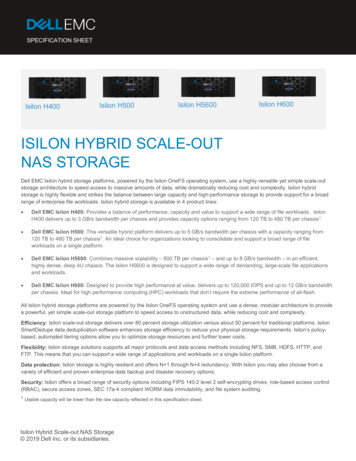

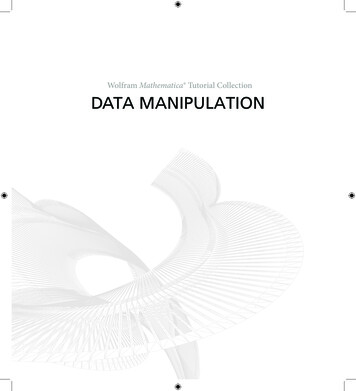
![[MS-ADTS-Diff]: Active Directory Technical Specification](/img/1/ms-adts-170316-diff.jpg)
